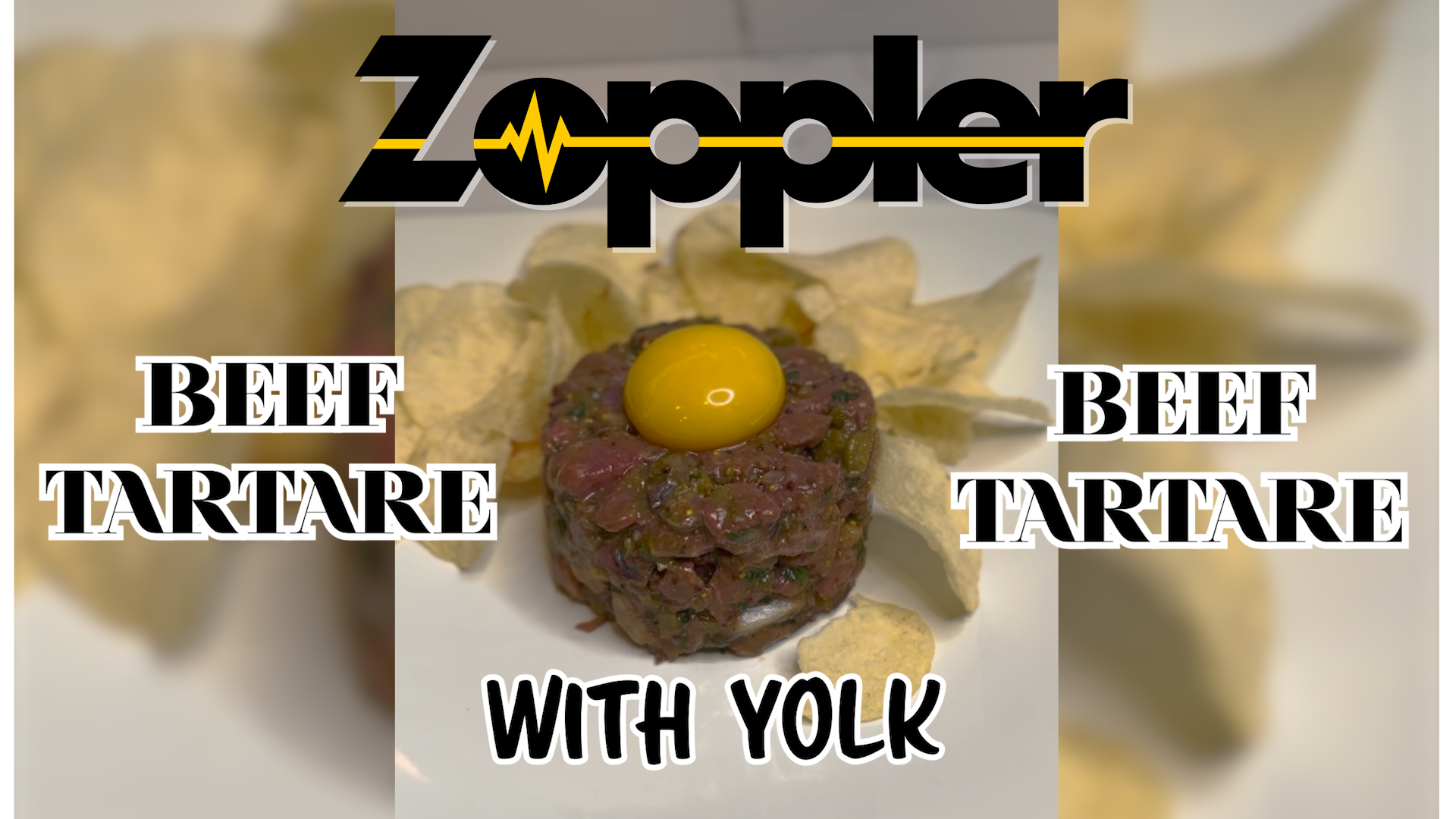Beef tartare, a beloved classic in the world of raw dishes, is a testament to the art of simplicity in cooking. With its origins rooted in French cuisine, the perfect beef tartare recipe offers a delectable fusion of textures, flavors, and the rich essence of quality beef. Making beef tartare at home may seem intimidating, but with the right ingredients, a little finesse, and close adherence to food safety guidelines, you can create a restaurant-worthy masterpiece in the comfort of your own kitchen.
In this article, we talk about everything there is to talk about when it comes to beef tartare, along with guiding you through the most incredible and easy beef tartare recipe you will find anywhere. Enjoy!
The Essence of Beef Tartare
Before we delve into the recipe and start you on this culinary adventure, it’s essential to understand the essence of beef tartare. At its core, it’s a dish made from finely minced, high-quality raw beef. The magic, however, lies in the marriage of ingredients that enhance the beef’s natural flavors and textures. These typically include capers, Dijon mustard, Worcestershire sauce, shallots, and a fresh egg yolk, often served with accompaniments like toasted bread, crackers, a simple green salad, or even regular potato chips.
The Easiest and Most Delicious Beef Tartare Recipe You Will Find Anywhere (Directions and ingredients directly below our recipe video):
Prep Time: 15 min
Rest time: 30 min
Total Time: 45 min
Ingredients:
- 1 – USDA Beef Tenderloin
- 1 Shallot
- 1 Italian Red Onion
- 4-5 Cornichons
- 2 Spoonful of Capers
- 1 Lemon
- 2 Tablespoons of Olive Oil
- 2 Tablespoons of Worcestershire Sauce
- Fresh Parsley
- 1 ½ Tablespoons of Stone Ground Mustard
- 1 ½ Tablespoons of Dijon Mustard
- 1 Fresh Egg
- Salt
- Pepper
The Process of Crafting this Decadent Dish:
Now that we’ve gathered our ingredients and equipment, let’s dive into the process of crafting homemade beef tartare:
- Prepare the Beef: As previously mentioned, start by placing your Beef Tenderloin in the freezer for an hour. It’ll help kill germs, bacteria, etc and make the meat nice and firm for cutting. Begin by cutting your high-quality beef into small cubes. Use your knife to finely mince the beef until you reach the desired texture.
- Mince the Aromatics: Finely chop the shallots, capers, red onion, cornichons and parsley. You want these ingredients to be minced so that they evenly distribute throughout the beef. We only used about ½ shallot, 1/3 red onion, 4-5 cornichons, and two spoonsful of capers
- The Perfect Seasonings: In a mixing bowl, combine your minced aromatics with your 50/50 blend of Ground Stone and Dijon mustard, Worcestershire sauce, olive oil, lemon juice, salt, and pepper. Mix these together to create a flavorful base for your tartare.
- Shape the Tartare: In all honesty, you can use whatever works to shape your tartare. A round metal ring, a measuring cup, or even an empty tuna can with both ends removed to shape the beef tartare into a neat round disk. This adds a professional touch to the presentation.
- Top with an Egg Yolk: Create a small well in the center of the tartare, and carefully place the egg yolk in the hollow. This not only looks stunning but also adds a luxurious creaminess to the dish.
- Chill and Serve: Cover the tartare with plastic wrap and place it in the refrigerator to chill for about 30 minutes. This not only firms up the dish but allows the flavors to meld. (We didn’t top with the Egg Yolk until after this process)
- Presentation: Serve your beef tartare with potato chips, toasted bread, crackers, or a simple green salad. Lemon wedges on the side allow diners to add a citrusy zing to their liking.
The Art of Ingredient Selection
Creating a “Michelin-star” beef tartare begins with choosing the right ingredients; and the beauty is that it’s really dependable on your own personal preferences and palate. Let’s explore each component:
Beef:
The best place to begin is with the star of the show. Make sure you only use the finest-quality beef you can find. Tenderloin, sirloin, or ribeye are excellent choices, but don’t be afraid to talk with your butcher and let them know you’ll be eating the meat raw; they can help point you in the best direction. The other important key is to make sure it’s fresh and stored at a safe, cool temperature (32-40°F or 0-4°C). One hour before starting the construction of your Beef Tartare, place the cut, still wrapped, in the freezer for one hour to limit bacteria and help with some of the safety measures.
Herbs and Aromatics:
- Shallots: Finely minced shallots provide a mild onion flavor that complements the beef’s richness.
- Red Onion: Enhance your sweet and rich flavors with a little Italian Red Onion.
- Capers: These little flavor bombs add a burst of tanginess.
- Parsley: Fresh, flat-leaf parsley, finely chopped, adds brightness to the dish.
- Cornichons: Optional, but if you love a bit of crunch and acidity, finely chopped cornichons can be a delightful addition.
Seasonings and Condiments:
- Dijon Mustard: This provides a spicy kick and acts as an emulsifier. You can also use Stone Ground Mustard, or a mix of both for different levels of flavor.
- Worcestershire Sauce: Adds depth of flavor with its umami notes.
- Salt and Pepper: Essential to enhance the taste of all the ingredients, especially the beef.
The Egg:
A fresh, high-quality egg yolk adds richness and a velvety texture. Ensure the egg is as fresh as your beef. For a little variation, you can try using a qual egg or duck egg to kick things up a notch on the exotic scale.
Presentation and Accompaniments:
- Bread or Crackers: Serve your beef tartare with toasted bread, crackers, or crostini.
- Potato Chips: Use standard Lays Potato Chips. The Crisp chip and salty taste provide a great vessel to enjoy this appetizer.
- Fresh Greens: A simple green salad with a light vinaigrette is a wonderful side dish.
- Lemon Wedges: These add a zesty, citrusy touch.
What You Need, All of The Essentials:
To make beef tartare, you won’t need a kitchen packed with gadgets. Here are the basics:
- Chef’s Knife: A sharp, high-quality chef’s knife is essential for finely mincing the beef and herbs. If you’re doing any cooking at home, invest in a good knife, it will always pay off.
- Cutting Board: Use a clean, sanitized cutting board to prep your ingredients.
- Mixing Bowl: A non-reactive mixing bowl, such as glass or stainless steel, is perfect for combining your ingredients.
- Plastic Wrap: For covering and chilling the tartare before serving.
- Egg Separator: If you want to separate the egg yolk with finesse, you can use a separator, or choose do this manually, utilizing the egg shell to separate the Yolk and white naturally
- Serving Plate: Choose a clean, aesthetically pleasing plate for presentation.
Food Safety: A Critical Component Not to Be Overlooked
Safety is paramount when working with raw meat and eggs. Follow these guidelines to ensure that your beef tartare is safe to consume:
- Freshness: Start with fresh, high-quality beef and a fresh egg.
- Temperature: Keep the beef and the finished tartare below 40°F (4°C) at all times.
- Cleanliness: Ensure your hands, utensils, and workspace is thoroughly sanitized.
- Storage: Consume the tartare the same day it’s prepared.
Variations are Endless, Don’t Be Afraid to Explore:
The beauty of beef tartare is its versatility. Once you’ve mastered the classic version, feel free to experiment with your own variations:
If you like some spice, don’t be afraid to add a touch of heat with minced chili peppers or a dash of hot sauce.
Do you want more richness, how about a light drizzle of truffle oil for that extra layer of flavor?
You love the classic version but want to see how different toppings taste? Experiment with things like grated horseradish, caviar, or a sprinkling of finely grated Parmesan.
We started this by saying you can serve a Michelin-Star Dish in the comfort of your home, so kick it up and notch and add some seafood! For a twist, try crafting a seafood tartare with fresh, high-quality fish or scallops, or simply top off the beef tartare with shrimp or lobster- BOOM! Now you’ve got Surf and Turf Tartare that will blow your guest (s) away.
What’s better than a good glass of wine with your steak? Keep the upscale dining experience going, and add a wine pairing. To elevate your dining experience, pair your beef tartare with a good wine. A crisp Chardonnay, a light Pinot Noir, or even a sparkling wine like Champagne can complement the dish’s rich, meaty flavors.
Chopped Champion Home Edition
Crafting beef tartare at home is a rewarding and impressive culinary feat. While it may seem challenging at first, the process is relatively straightforward with the right ingredients, equipment, and attention to safety. Once you take that first bite of your homemade beef tartare, you’ll discover the perfect balance of flavors and textures that make it a cherished dish worldwide. Whether you’re serving it at a dinner party or savoring it for a special occasion, your homemade beef tartare is sure to be a hit, showcasing your culinary skills and appreciation for the finer things in life.
The History of Beef Tartare
Beef Tartare, a culinary delight renowned for its raw, finely minced beef, has a captivating history. Its origins are rooted in Eastern European and Russian cuisine, particularly in countries like Russia and Ukraine. In these regions, people relished raw beef mixed with spices and seasonings, sometimes referred to as “kibbeh” or “steak à la tartare.” The name “Tartare” likely alludes to the Tatars, a historical group often associated with consuming raw meat.
This dish eventually made its way to France, where it evolved into the elegant Beef Tartare we recognize today. In the 19th century, it gained popularity in French bistros and restaurants, often served with accompaniments like raw egg yolk, capers, onions, and mustard.
Over time, a good Beef Tartare recipe has become a symbol of gourmet dining, adored for its combination of fresh, high-quality beef, and a medley of bold flavors. Its history reflects a culinary journey that transcends borders and continues to captivate the palates of discerning food enthusiasts worldwide.
What Makes Beef Tartare Such a Popular Appetizer?
Beef Tartare is a popular appetizer for several reasons:
- Unique and Elegant: Beef Tartare is not an everyday dish, and its presentation is often seen as sophisticated and refined. Its exclusivity and the art of crafting it make it an attractive choice for those looking to start a meal on a memorable note.
- Rich Flavor Profile: The combination of raw, high-quality beef with ingredients like capers, mustard, onions, and egg yolk creates a rich and complex flavor profile. It offers a symphony of tastes, from the natural umami of the beef to the tangy and spicy notes of the accompaniments.
- Freshness and Quality: Beef Tartare demands the use of the freshest, top-quality beef. This commitment to freshness and sourcing the best ingredients underscores the dedication to culinary excellence.
- Customization: It’s a dish that allows for personalization. Diners can adjust the seasonings and condiments to tailor the flavor to their preferences, making it an interactive and engaging choice.
- Texture and Temperature: The contrast between the tender, uncooked beef and the various crunchy, tangy accompaniments, along with the cool temperature, provides a unique sensory experience that appeals to many.
- Health and Dietary Preferences: Beef Tartare is a low-carb and high-protein option, making it suitable for those following specific diets, such as keto or paleo.
- Culinary Adventure: Trying Beef Tartare can be an exciting and adventurous culinary experience. It’s a departure from traditional cooked dishes, and for those willing to explore their palates, it offers a memorable taste adventure.
Overall, Beef Tartare’s popularity lies in its combination of exquisite flavors, quality ingredients, and the sense of sophistication it imparts, making it a favorite among appetizer choices for those seeking a memorable dining experience.
What Are The Best Cuts of Meat to Use for Beef Tartare?
When making Beef Tartare recipe, it’s essential to choose a high-quality cut of meat that is tender and has the right balance of lean and fat. Some of the best cuts of meat for Beef Tartare include:
- Filet Mignon: This is often considered the top choice for Beef Tartare due to its tenderness and minimal marbling. It’s exceptionally lean and results in a delicate texture.
- Sirloin: Sirloin steak is another excellent option, as it offers a balance of lean meat and some marbling for added flavor.
- Ribeye: Ribeye is a more flavorful choice due to its higher fat content. While it may not be as lean as filet mignon, it can provide a richer taste and mouthfeel.
- Top Round: Top round, also known as the London broil, can be a good choice if you’re looking for a lean cut with a slightly firmer texture.
- Tenderloin: Similar to filet mignon, tenderloin is a very tender and lean cut. It’s prized for its mild flavor and smooth texture.
Remember, whichever cut you choose, it’s crucial to ensure the meat is fresh, properly handled, and sourced from a reputable supplier. It should also be trimmed of any connective tissue and sinew before mincing. Additionally, you can ask your butcher for their recommendations, as they may have insights into the best cuts available.
How Can You Comprise the Best Steak Tartare Recipes on Your Own?
Compiling the “best” Steak Tartare recipes involves incorporating elements that highlight the dish’s key attributes: quality, flavor, and texture. Here’s how to compile a winning Steak Tartare recipe:
- Select the Right Cut: Begin with the finest, freshest, and leanest cuts of beef, like filet mignon or sirloin. Ensuring quality at the starting point is crucial.
- Meticulous Preparation: Hand-mincing the meat with a sharp knife, rather than using a food processor, helps control the texture and consistency.
- Balanced Seasonings: Achieve a harmonious blend of flavors by balancing capers, mustard, onions, and other seasonings. Customize the seasoning to suit your palate.
- Fresh Ingredients: Use only fresh ingredients. This includes zesty lemon juice, flavorful olive oil, and a farm-fresh egg.
- Presentation: Aesthetics matter. Serve your Steak Tartare artfully, garnished with chopped parsley and perhaps a raw egg yolk.
- Texture: Strive for the right texture, where the meat is tender but still retains some texture. Ensure the dish is well-chilled.
- Safety First: Always use high-quality, fresh, and safe-to-eat raw ingredients. Handle and store them properly.
- Accompaniments: Offer traditional accompaniments like cornichons and crusty bread, as well as optional extras like truffle oil, or unique touches to elevate your recipe.
- Creativity: While tradition matters, feel free to add a personal touch. Experiment with flavors and textures, from using different types of mustard to incorporating unexpected ingredients like caperberries.
- Serve Immediately: Steak Tartare is at its best when it’s made and served right away. This ensures the freshest flavors and textures.
Remember, the “best” Steak Tartare recipe can be a matter of personal preference. Tastes vary, so don’t hesitate to adapt the recipe to your liking, exploring different variations until you find the one that resonates most with your palate.
To Sum it Up
In the world of culinary delights, few dishes rival the timeless elegance and sensory allure of a great Beef Tartare Recipe. With its fascinating history and a variety of sumptuous ingredients, this appetizer has captured the hearts and palates of discerning food lovers worldwide. While there are countless approaches to crafting the perfect Beef Tartare, the quest for the “best” recipe is subjective, guided by personal tastes and preferences. Nevertheless, the true magic of Beef Tartare lies in its simplicity and the quality of the ingredients used. So whether you opt for a classic preparation or experiment with unique twists, the journey of savoring this exquisite dish is where you’ll find the ultimate recipe – one that resonates with your culinary soul and leaves a lasting impression on your taste memories.
Zoppler is reader supported and may earn affiliate commissions from links on this page. We support and believe in all the products and services we promote and are affiliated with.











